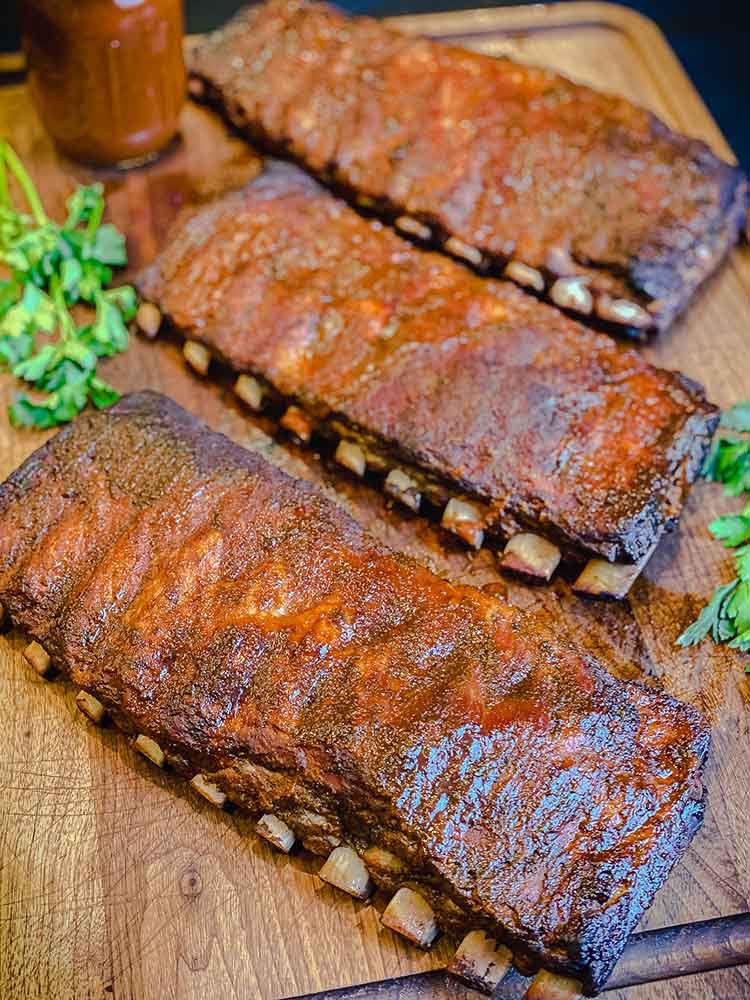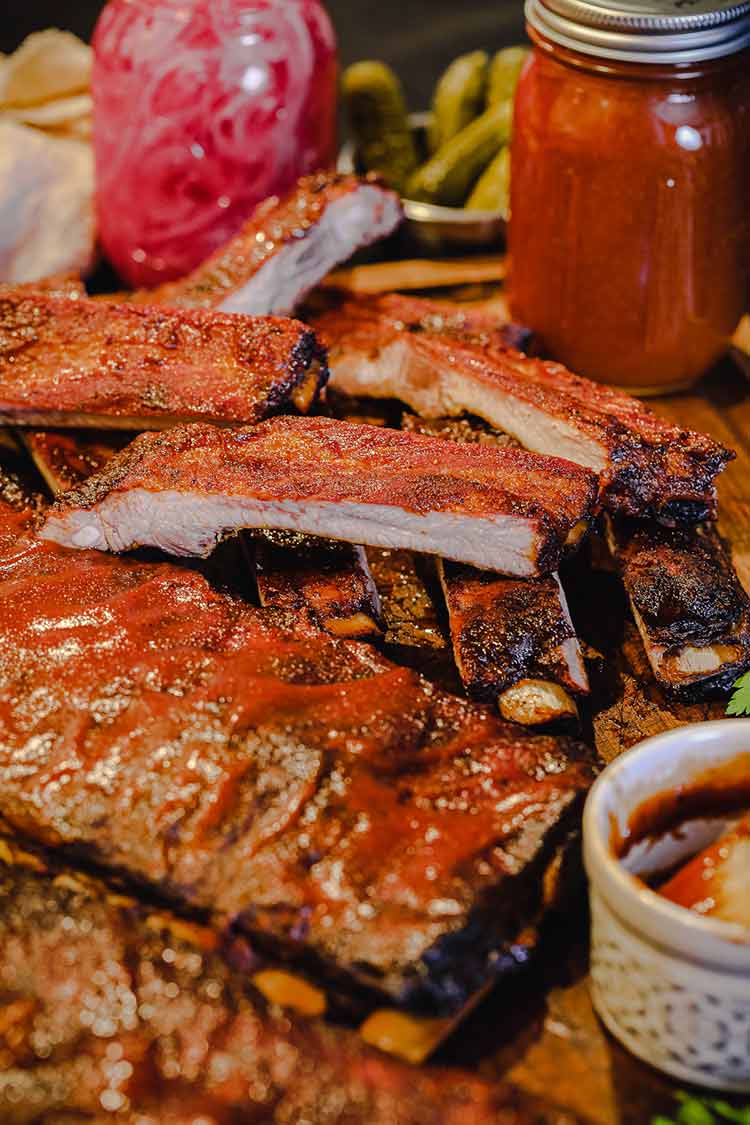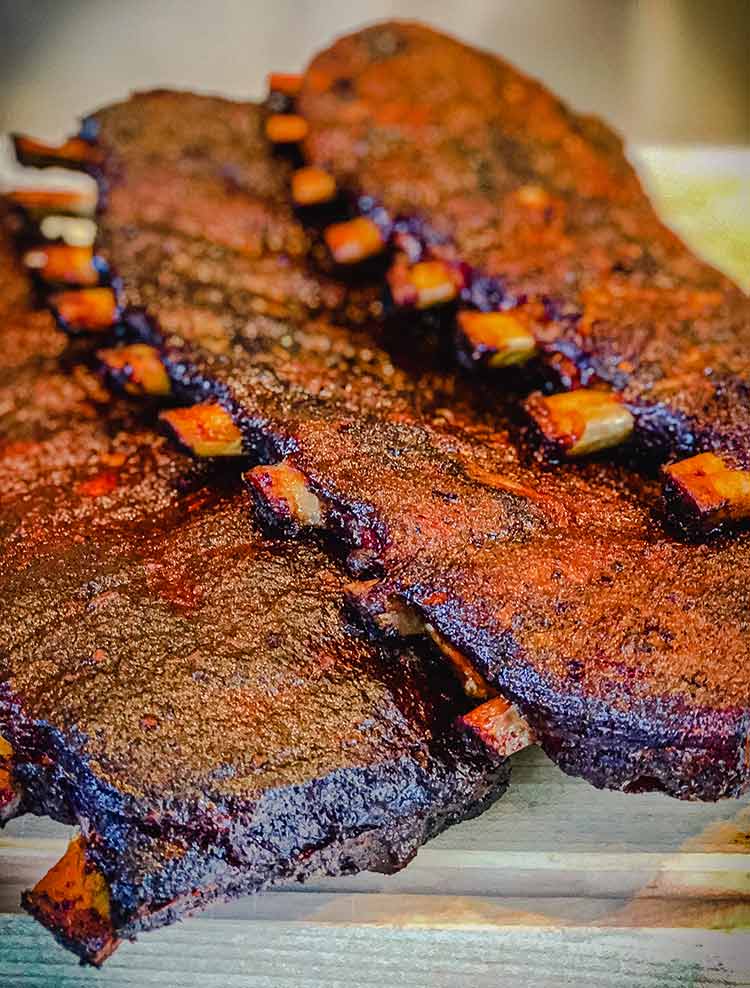Pork ribs (either St. Saint Louis-style spare ribs or baby back ribs are simple to cook, but it can be hard to tell when they’re done unless you’re a seasoned pit master.
After reading this blog to the end, you’ll know definitively when your pork ribs are done.
You can tell when pork ribs are ready in a number of ways, but different sources may give you different information, leaving you wondering which is the best way to tell.
Which method can you trust? Which one really works? Do you just believe what your coworker says after cooking three racks of ribs and calling themselves a pitmaster?
Do you break a few racks trying to figure it out? It’s embarrassing to say that I may “know someone” who did that and it cost them a lot. There’s no need for any of that, I promise.
Cooking pork ribs can seem daunting to backyard grillers. With the membrane, tough cartilage and bone, ribs can easily end up dry or underdone without the right technique. But achieving fall-off-the-bone tender pork ribs is easier than you think when you nail the ideal temperature.
The target temperature for pork ribs is 190-200°F Cooking low and slow allows the collagen to melt, making the ribs succulent and finger-licking good. Follow these tips for ribs cooked to perfection
Choose the Right Style of Rib
The first step is selecting the right cut of pork rib to suit your preferences
-
Baby back ribs – From the rib section near the loin, these are shorter, meatier and leaner.
-
Spare ribs – From belly side with more fat and cartilage. Need longer cooking but very flavorful.
-
Country-style ribs – Meatier like spare ribs but cut from shoulder. Marbled with fat.
-
St. Louis ribs – Pork spare ribs trimmed into rectangles. More surface area = more bark.
Baby backs and St. Louis ribs cook faster than spareribs. Country ribs are nicely marbled for moistness. Pick your favorite or mix it up!
Remove the Membrane
Pork ribs have a silvery membrane coating the underside of the bones. It can get tough when cooked. For tender ribs, slip a butter knife under the membrane, grab hold and peel it off. This allows smoke and sauces to penetrate.
Season Liberally
Ribs need aggressive seasoning to stand up to long cooking times. Coat them all over with:
- Brown sugar or maple syrup for sweetness
- Paprika, garlic and onion powder
- Chilli powder or cayenne for heat (optional)
- Salt and black pepper
Let the seasoned ribs sit while you preheat your grill or smoker.
Grill Low and Slow
The secret to incredibly tender, fall-off-the-bone ribs is cooking them low and slow. This gives the connective tissues time to break down into succulent, finger-licking meat.
- Temperature: Maintain a grill temp between 225-275°F.
- Time: 4-6 hours depending on thickness. Baby backs take less time than spareribs or country ribs.
- Wood: Opt for fruit woods like apple, cherry or peach which pair perfectly with pork.
Maintaining an even, consistent temperature is key. Use tongs, not forks, when flipping to prevent poking holes.
Know When They’re Done
Checking temperature is the only foolproof way to know when ribs are perfectly cooked. Use an instant read thermometer to take multiple readings along the ribs.
- Insert into thickest meatiest areas, avoiding bone.
- Test at both ends and middle since they cook unevenly.
- Target internal temp is 190-200°F for fall-off-the-bone ribs.
At this temp, the collagen has melted to create tender meat that barely clings to the bone. If under 190°F they will be tough.
Allow Time to Rest
After cooking, resist cutting into the ribs right away. Let them rest for 15-30 minutes, lightly tented in foil. This allows juices time to redistribute so they don’t run out when cutting.
During rest time, the internal temperature continues rising 5-10°F due to carryover cooking. So pull them off the grill just shy of 200°F.
Add Smoky, Sweet Barbecue Sauce
During the last 10-15 minutes of grilling, start basting the ribs with barbecue sauce to caramelize it. Use a sauce that complements the dry rub flavors.
Brush sauce on both sides, avoiding any burnt or charred spots. The sugars will bubble and caramelize, giving a lovely char and glaze.
Step-By-Step Guide for Perfect Grilled Ribs
Follow this simple technique for outstanding ribs every time:
-
Prep ribs by peeling off membrane and trimming excess fat.
-
Generously season both sides with spices, salt, pepper and brown sugar.
-
Allow ribs to come to room temp while you preheat grill to 225-250°F.
-
Place ribs meaty side up on grill grates over indirect heat.
-
Grill for 4-6 hours, maintaining even temperature. Flip and rotate ribs every 45-60 minutes.
-
During last 15 minutes, brush ribs with barbecue sauce to glaze. Avoid any burnt areas.
-
Check temp in a few spots using a meat thermometer until 190°F.
-
Remove ribs from grill and tent loosely with foil. Allow to rest 15-30 minutes.
-
Slice ribs between bones into individual pieces. Serve warm with extra sauce.
Handy Pork Rib Tips
-
Choose ribs similar in size and thickness for even cooking.
-
Leave membrane on bones facing down to protect from burning.
-
Use rib racks to maximize grill space if cooking large batches.
-
Add smoked apple juice, beer or water to a foil pan under the ribs to create steam.
-
Spritz ribs hourly with juice or vinegar to keep moist. Avoid sugary spritzes that can burn.
-
Insert wood chunks directly into coals for smoke, replacing as needed.
-
Apply sauce too early and it will burn. Wait until nearly done.
-
Hold finished ribs in a cooler wrapped in towels to keep hot and juicy if serving later.
Test for Doneness Without a Thermometer
If you don’t have a meat thermometer, use the bend test. Gently lift ribs with tongs – if they bend and crack slightly rather than breaking cleanly, they should be nicely tender.
Also check that the meat has shrunk back from the ends of the bones by 1⁄4 to 1⁄2 inch. If still firmly attached to bones, they need more time.
Serve Juicy Pork Ribs a Myriad of Ways
The right internal temperature yields ribs so tender the meat pulls clean off the bone. Pile onto plates and serve with:
- Baked beans, coleslaw, cornbread and pickles for a backyard BBQ
- Mac and cheese, collard greens and potatoes for comfort food
- Rice, roasted veggies and salad for a healthier rib dinner
- On brioche buns with pickles and slaw for pulled pork sandwiches
- Chopped on nachos, in quesadillas, tacos or empanadas
Leftover ribs make amazing fried rice, soups, pasta dishes and more. Freeze leftover portions to enjoy again later.
Perfectly cooked, saucy pork ribs are a crowdpleasing treat! Just remember to take them low and slow until 190°F. In a matter of hours, you’ll be indulging in finger-licking ribs that fall right off the bone.

At What Temperature Are Pork Ribs Done?
The USDA recommends cooking pork ribs to an internal temperature of 145° F for safety reasons. However, at this temperature the meat is rubbery and tough. Pork internal temp and pork done temp are clearly not the same thing.
Pork ribs aren’t ready to be served until their internal temperature reaches 195° F to 203° F. At this temperature, fat and collagen throughout the meat has broken down and flavored the ribs.
This contributes to the overall taste and texture of the ribs. If the bones peek out and they probe easily at 195° F, I pull them off the grill. There are no bones that stick out if the probe is still tight. I let them heat up to 203° F and then take them off.

Finally, the meat should keep its shape after biting into it. You may have heard that ribs are perfectly cooked when they “fall off the bone. ” That is actually not true. If the meat falls off the bone, it’s overcooked and has a mushy texture—not ideal for any occasion. The moral of the story is that you should trust a thermometer (like the ThermoWorks Signals or the ThermoWorks Smoke X2 RF) to give you juicy ribs that everyone will want more of!

What Traditional Techniques Miss: Internal Temperature
The problem with all of these methods is twofold. First, if you have never cooked before, you might not know how deep a crack should be or how easy it should be for the probe to slide in and out, etc. Further, while a good indication, bones sticking out from the meat doesn’t always happen.
Second, and more important, these methods are never 100% accurate. Although they work well as general rules, why take the chance of wasting six hours of your time and a great rack of ribs when technology could make it easier to be accurate?

What Temperature Should I Cook My Ribs?
FAQ
Are pork ribs done at 160 degrees?
Are ribs done at 170?
Is it safe to eat pork ribs at 145?
Are pork ribs done at 185?
